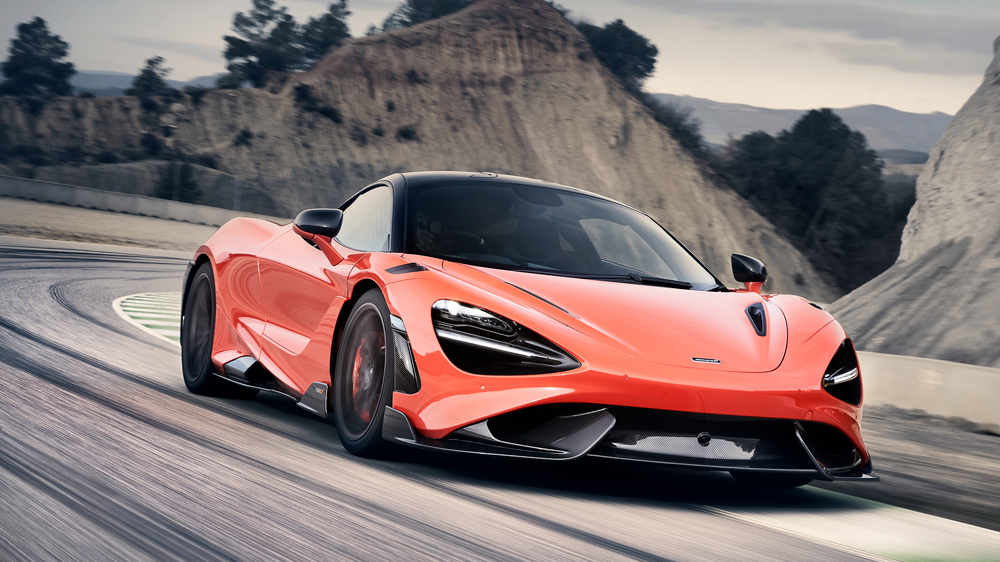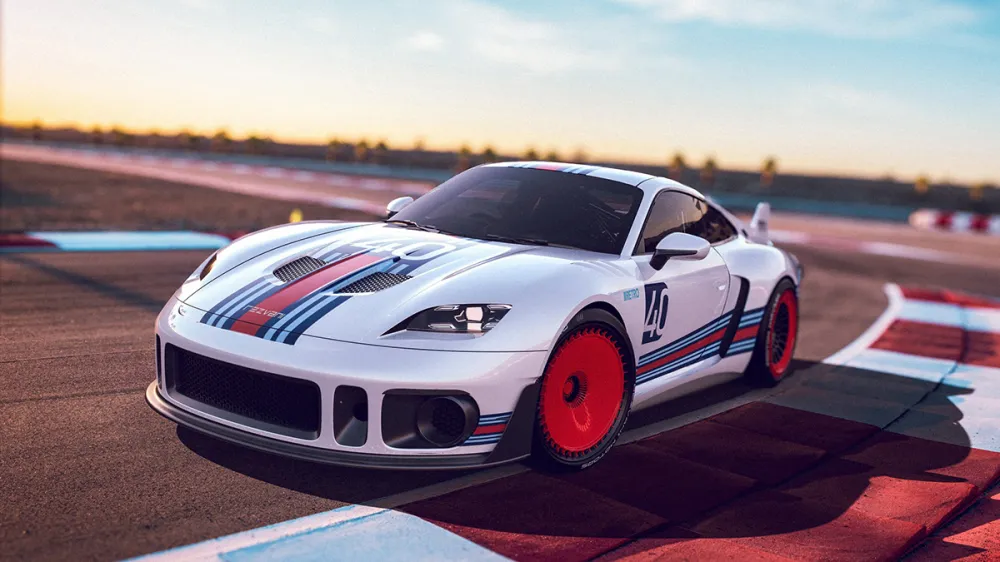
Robb Review: McLaren 765LT
Lighter and quicker than its 720S sibling, the latest in McLaren’s Super Series is best left for the track.
Related articles
The 765LT has a base of $600,000, excluding on-roads, and only 765 examples will be produced (with the entire Australian allocation already sold out for 2021). The body was painted a color called Ceramic Gray, a $12,900 option with a distinct lilac tint that received compliments from many observers. Punctuated with orange calipers and black carbon-fiber bits, the car is a striking outlier parked next to almost anything else on four wheels—short of a few Italians and one French marque that come to mind.
The 765LT looks to be from another planet. That’d be a planet with wide roads, because the McLaren, while low—it’s only 1.2m high—is broad of beam. At 2.15m side-to-side with mirrors spread, that’s only a touch wider than a super king sized mattress, most of which do not ride as firmly as the McLaren.

A total of 765 examples of the car will be produced. Photo: Courtesy of McLaren Automotive Limited.
According to its designers, the 765LT’s mission is track-focused, and not aimed at everyday comfort in the manner of the 720S or, certainly, McLaren’s new GT. The driver is connected to everything, which is all felt by the seat-of-the-pants through components like stiffer engine mounts and vise-like carbon-ceramic brakes. Brake calipers from the McLaren Senna poke out from behind 10-spoke ultra-lightweight forged alloy wheels—19- and 20-inch front and rear, respectively—using titanium wheel bolts and running Pirelli P Zero Trofeo R tyres.
The most obvious connection to all that performance is McLaren’s 4.0-litre, twin-turbocharged V-8 engine, its uprated internals helping to deliver 563kW at 7,500 rpm and 800Nm of torque at 5500rpm. Those numbers, while hardly immodest, cannot convey the explosive acceleration and power band of the engine, which gets the 765LT from zero to 97km/h in 2.7 seconds, due in part to the seven-speed Sequential Shift gearbox with shortened gear ratios. Top speed is 330km/h, and half that velocity is achieved in seconds. It’s with such accelerative antics that the 765LT reminds us that its place really is on a circuit and not civilian asphalt.

The 563kW McLaren 765LT covers zero to 97km/h mph in 2.7 seconds and has a top speed of 330km/h. Photo: Courtesy of McLaren Automotive Limited.
Outwardly, the McLaren declares its competitive personality with a longer front overhang, deeper front splitter, long-tailed rear with its huge lower diffusor and an active rear wing that could double as a surfboard. As with other state-of-the-art supercars, active aerodynamics are key to speed, stability, handling and safety. Wicked side blades extend from the front wheels and across the doors and, combined with other bodywork, help create 25 percent greater downforce than the 720S. Optional front fender louvers aid cooling, further improve downforce and just plain look cool.
As noted, the 765LT is a big car, and not one to be glibly flicked into the tightest hairpins welcomed by any Lotus, Miata or even mid-engine Porsche. It’s for sweepers, running flat out on an empty highway or, better yet, on the tarmac.

The back of the vehicle features the performance-enhancing titanium exhaust, a huge lower diffusor and large active rear wing. Photo: Courtesy of McLaren Automotive Limited.
Despite its built-for-performance persona, the 765LT features an interior that’s not bereft of creature comforts. Once over the high side sill, occupants tumble into comfortable sports seats. The well-executed Alcantara upholstery, tidy switchgear and minimalist centre-tunnel touchscreen create a sober environment, which is a nice change from the visual assault of some glass cockpits—busier than a video pinball arcade. Two identical rotary switches on the central tunnel, one for engine and one for suspension, allow the driver to select modes for Comfort, Sport and Track, dialing in increasing amounts of aggression as one goes from C to T. Absent any selection, the car does its thing automatically and without any gear-change intervention from the driver. Manual shifts are possible via the paddle shifters, which rotate with the steering wheel and will require mental adjustment for drivers more familiar with stationary stalks.
Truth be told, the auto-shift, even in full-anger Track mode, is far and away the most efficient way to tackle shifting, and allows drivers to concentrate on the road ahead, which spools up real fast thanks to the McLaren’s blistering acceleration. One neat parlor trick is the digital display directly in front of the driver, which shows a full dash-load of “instruments” in Auto, Comfort and Sport, but which rotates to become a sliver of LEDs that show only rpm and the selected gear when in Track.

The Alcantara-clad interior includes tidy switchgear and a minimalist centre-tunnel touchscreen. Photo: Courtesy of McLaren Automotive Limited.
McLaren engineers are justifiably proud of the lightweight, performance-enhancing titanium exhaust. It adds some high-strung urgency to the 765LT engine’s soundtrack, which doesn’t really sound like any other engine at all. But fans of the Prancing Horse still have the best sounding V-8 by a wide margin.
Stabbing the start button and setting off for an early morning drive down my hill to the boulevard below, the 765LT reminds me that it’s not happy being pressed into service as mere transportation, especially from a cold slumber. The carbon monocoque cage may be as stiff as Cheops’ pyramid, but until the drivetrain is warm, creaks and bucking shifts punctuate the first stretch, as if the machine got up on the wrong side of the bed. Owners desiring a magic carpet ride will need to look to McLaren’s neighbor in Goodwood, an hour south of the Woking factory, where Rolls-Royce Motor Cars set the bar for wafting tranquility.

The car’s side blades, which extend from the front wheels and across the doors, help the 675LT create 25 per cent greater downforce than the 720S. Photo: Courtesy of McLaren Automotive Limited.
Once things warm and the athlete gains its stride, however, everything changes—in a flash. Most cars convey a relative sense of velocity, but alarmingly, triple-digit speeds feel like half that in the 765LT, and it’s easy to run afoul of speed limits without even trying. As a habitual user of the rearview mirror, I find it ironic that as the speed increases, the active-aero wing elevates higher and higher, completely obscuring visibility through the rear window.
Drivers will find themselves backing off the throttle more than usual. And that is precisely why this McLaren is a track tool, thinly disguised as a street machine. Sure, it can shuttle from Point A to Point B with the same enthusiasm as Seabiscuit hitched to a 20-mule-team wagon. But for those desiring the sharpest track tool in the drawer, the McLaren 765LT will not disappoint when allowed to stretch its legs in the environment for which it was bred.
Subscribe to the Newsletter
Recommended for you
8 Fascinating Facts You Didn’t Know About Aston Martin
The British sports car company is most famous as the vehicle of choice for James Bond, but Aston Martin has an interesting history beyond 007.
May 1, 2024
Rezvani Will Rebuild Your 911 to Go From Zero to 100 in Two Seconds
The shop will build a version of the RR1 based on the Carrera S, GT3, and Turbo S
By Bryan Hood
April 23, 2024
You may also like.
You may also like.
Watch of the Week: TAG Heuer Formula 1 | Kith
The legendary sports watch returns, but with an unexpected twist.
Over the last few years, watch pundits have predicted the return of the eccentric TAG Heuer Formula 1, in some shape or form. It was all but confirmed when TAG Heuer’s heritage director, Nicholas Biebuyck, teased a slew of vintage models on his Instagram account in the aftermath of last year’s Watches & Wonders 2023 in Geneva. And when speaking with Frédéric Arnault at last year’s trade fair, the former CEO asked me directly if the brand were to relaunch its legacy Formula 1 collection, loved by collectors globally, how should they go about it?
My answer to the baited entreaty definitely didn’t mention a collaboration with Ronnie Fieg of Kith, one of the world’s biggest streetwear fashion labels. Still, here we are: the TAG Heuer Formula 1 is officially back and as colourful as ever.
As the watch industry enters its hype era—in recent years, we’ve seen MoonSwatches, Scuba Fifty Fathoms, and John Mayer G-Shocks—the new Formula 1 x Kith collaboration might be the coolest yet.

Here’s the lowdown: overnight, TAG Heuer, together with Kith, took to socials to unveil a special, limited-edition collection of Formula 1 timepieces, inspired by the original collection from the 1980s. There are 10 new watches, all limited, with some designed on a stainless steel bracelet and some on an upgraded rubber strap; both options nod to the originals.
Seven are exclusive to Kith and its global stores (New York, Los Angeles, Miami, Hawaii, Tokyo, Toronto, and Paris, to be specific), and are made in an abundance of colours. Two are exclusive to TAG Heuer; and one is “shared” between TAG Heuer and Kith—this is a highlight of the collection, in our opinion. A faithful play on the original composite quartz watch from 1986, this model, limited to just 1,350 pieces globally, features the classic black bezel with red accents, a stainless steel bracelet, and that creamy eggshell dial, in all of its vintage-inspired glory. There’s no doubt that this particular model will present as pure nostalgia for those old enough to remember when the original TAG Heuer Formula 1 made its debut.

Of course, throughout the collection, Fieg’s design cues are punctuated: the “TAG” is replaced with “Kith,” forming a contentious new brand name for this specific release, as well as Kith’s slogan, “Just Us.”
Collectors and purists alike will appreciate the dedication to the original Formula 1 collection: features like the 35mm Arnite cases—sourced from the original 80s-era supplier—the form hour hand, a triangle with a dot inside at 12 o’clock, indices that alternate every quarter between shields and dots, and a contrasting minuterie, are all welcomed design specs that make this collaboration so great.
Every TAG Heuer Formula 1 | Kith timepiece will be presented in an eye-catching box that complements the fun and colour theme of Formula 1 but drives home the premium status of this collaboration. On that note, at $2,200 a piece, this isn’t exactly an approachable quartz watch but reflects the exclusive nature of Fieg’s Kith brand and the pieces he designs (largely limited-edition).

So, what do we think? It’s important not to understate the significance of the arrival of the TAG Heuer Formula 1 in 1986, in what would prove integral in setting up the brand for success throughout the 90’s—it was the very first watch collection to have “TAG Heuer” branding, after all—but also in helping to establish a new generation of watch consumer. Like Fieg, many millennial enthusiasts will recall their sentimental ties with the Formula 1, often their first timepiece in their horological journey.
This is as faithful of a reissue as we’ll get from TAG Heuer right now, and budding watch fans should be pleased with the result. To TAG Heuer’s credit, a great deal of research has gone into perfecting and replicating this iconic collection’s proportions, materials, and aesthetic for the modern-day consumer. Sure, it would have been nice to see a full lume dial, a distinguishing feature on some of the original pieces—why this wasn’t done is lost on me—and perhaps a more approachable price point, but there’s no doubt these will become an instant hit in the days to come.
—
The TAG Heuer Formula 1 | Kith collection will be available on Friday, May 3rd, exclusively in-store at select TAG Heuer and Kith locations in Miami, and available starting Monday, May 6th, at select TAG Heuer boutiques, all Kith shops, and online at Kith.com. To see the full collection, visit tagheuer.com
You may also like.
8 Fascinating Facts You Didn’t Know About Aston Martin
The British sports car company is most famous as the vehicle of choice for James Bond, but Aston Martin has an interesting history beyond 007.
Aston Martin will forever be associated with James Bond, ever since everyone’s favourite spy took delivery of his signature silver DB5 in the 1964 film Goldfinger. But there’s a lot more to the history of this famed British sports car brand beyond its association with the fictional British Secret Service agent.
Let’s dive into the long and colourful history of Aston Martin.
You may also like.
What Venice’s New Tourist Tax Means for Your Next Trip
The Italian city will now charge visitors an entry fee during peak season.
Visiting the Floating City just got a bit more expensive.
Venice is officially the first metropolis in the world to start implementing a day-trip fee in an effort to help the Italian hot spot combat overtourism during peak season, The Associated Press reported. The new program, which went into effect, requires travellers to cough up roughly €5 (about $AUD8.50) per person before they can explore the city’s canals and historic sites. Back in January, Venice also announced that starting in June, it would cap the size of tourist groups to 25 people and prohibit loudspeakers in the city centre and the islands of Murano, Burano, and Torcello.
“We need to find a new balance between the tourists and residents,’ Simone Venturini, the city’s top tourism official, told AP News. “We need to safeguard the spaces of the residents, of course, and we need to discourage the arrival of day-trippers on some particular days.”
During this trial phase, the fee only applies to the 29 days deemed the busiest—between April 25 and July 14—and tickets will remain valid from 8:30 am to 4 pm. Visitors under 14 years of age will be allowed in free of charge in addition to guests with hotel reservations. However, the latter must apply online beforehand to request an exemption. Day-trippers can also pre-pay for tickets online via the city’s official tourism site or snap them up in person at the Santa Lucia train station.
“With courage and great humility, we are introducing this system because we want to give a future to Venice and leave this heritage of humanity to future generations,” Venice Mayor Luigi Brugnaro said in a statement on X (formerly known as Twitter) regarding the city’s much-talked-about entry fee.
Despite the mayor’s backing, it’s apparent that residents weren’t totally pleased with the program. The regulation led to protests and riots outside of the train station, The Independent reported. “We are against this measure because it will do nothing to stop overtourism,” resident Cristina Romieri told the outlet. “Moreover, it is such a complex regulation with so many exceptions that it will also be difficult to enforce it.”
While Venice is the first city to carry out the new day-tripper fee, several other European locales have introduced or raised tourist taxes to fend off large crowds and boost the local economy. Most recently, Barcelona increased its city-wide tourist tax. Similarly, you’ll have to pay an extra “climate crisis resilience” tax if you plan on visiting Greece that will fund the country’s disaster recovery projects.
You may also like.
Omega Reveals a New Speedmaster Ahead of the Paris 2024 Olympics
Your first look at the new Speedmaster Chronoscope, designed in the colour theme of the Paris Olympics.
The starters are on the blocks, and with less than 100 days to go until the Paris 2024 Olympics, luxury Swiss watchmaker Omega was bound to release something spectacular to mark its bragging rights as the official timekeeper for the Summer Games. Enter the new 43mm Speedmaster Chronoscope, available in new colourways—gold, black, and white—in line with the colour theme of the Olympic Games in Paris this July.
So, what do we get in this nicely-wrapped, Olympics-inspired package? Technically, there are four new podium-worthy iterations of the iconic Speedmaster.

The new versions present handsomely in stainless steel or 18K Moonshine Gold—the brand’s proprietary yellow gold known for its enduring shine. The steel version has an anodised aluminium bezel and a stainless steel bracelet or vintage-inspired perforated leather strap. The Moonshine Gold iteration boasts a ceramic bezel; it will most likely appease Speedy collectors, particularly those with an affinity for Omega’s long-standing role as stewards of the Olympic Games.
Notably, each watch bears an attractive white opaline dial; the background to three dark grey timing scales in a 1940s “snail” design. Of course, this Speedmaster Chronoscope is special in its own right. For the most part, the overall look of the Speedmaster has remained true to its 1957 origins. This Speedmaster, however, adopts Omega’s Chronoscope design from 2021, including the storied tachymeter scale, along with a telemeter, and pulsometer scale—essentially, three different measurements on the wrist.
While the technical nature of this timepiece won’t interest some, others will revel in its theatrics. Turn over each timepiece, and instead of a transparent crystal caseback, there is a stamped medallion featuring a mirror-polished Paris 2024 logo, along with “Paris 2024” and the Olympic Rings—a subtle nod to this year’s games.
Powering this Olympiad offering—and ensuring the greatest level of accuracy—is the Co-Axial Master Chronometer Calibre 9908 and 9909, certified by METAS.

A Speedmaster to commemorate the Olympic Games was as sure a bet as Mondo Deplantis winning gold in the men’s pole vault—especially after Omega revealed its Olympic-edition Seamaster Diver 300m “Paris 2024” last year—but they delivered a great addition to the legacy collection, without gimmickry.
However, the all-gold Speedmaster is 85K at the top end of the scale, which is a lot of money for a watch of this stature. By comparison, the immaculate Speedmaster Moonshine gold with a sun-brushed green PVD “step” dial is 15K cheaper, albeit without the Chronoscope complications.
—
The Omega Speedmaster Chronoscope in stainless steel with a leather strap is priced at $15,725; stainless steel with steel bracelet at $16,275; 18k Moonshine Gold on leather strap $54,325; and 18k Moonshine Gold with matching gold bracelet $85,350, available at Omega boutiques now.
Discover the collection here
You may also like.
Here’s What Goes Into Making Jay-Z’s $1,800 Champagne
We put Armand de Brignac Blanc de Noirs Assemblage No. 4 under the microsope.
In our quest to locate the most exclusive and exciting wines for our readers, we usually ask the question, “How many bottles of this were made?” Often, we get a general response based on an annual average, although many Champagne houses simply respond, “We do not wish to communicate our quantities.” As far as we’re concerned, that’s pretty much like pleading the Fifth on the witness stand; yes, you’re not incriminating yourself, but anyone paying attention knows you’re probably guilty of something. In the case of some Champagne houses, that something is making a whole lot of bottles—millions of them—while creating an illusion of rarity.
We received the exact opposite reply regarding Armand de Brignac Blanc de Noirs Assemblage No. 4. Yasmin Allen, the company’s president and CEO, told us only 7,328 bottles would be released of this Pinot Noir offering. It’s good to know that with a sticker price of around $1,800, it’s highly limited, but it still makes one wonder what’s so exceptional about it.
Known by its nickname, Ace of Spades, for its distinctive and decorative metallic packaging, Armand de Brignac is owned by Louis Vuitton Moët Hennessy and Jay-Z and is produced by Champagne Cattier. Each bottle of Assemblage No. 4 is numbered; a small plate on the back reads “Assemblage Four, [X,XXX]/7,328, Disgorged: 20 April, 2023.” Prior to disgorgement, it spent seven years in the bottle on lees after primary fermentation mostly in stainless steel with a small amount in concrete. That’s the longest of the house’s Champagnes spent on the lees, but Allen says the winemaking team tasted along the way and would have disgorged earlier than planned if they’d felt the time was right.
Chef de cave, Alexandre Cattier, says the wine is sourced from some of the best Premier and Grand Cru Pinot Noir–producing villages in the Champagne region, including Chigny-les-Roses, Verzenay, Rilly-la-Montagne, Verzy, Ludes, Mailly-Champagne, and Ville-sur-Arce in the Aube département. This is considered a multi-vintage expression, using wine from a consecutive trio of vintages—2013, 2014, and 2015—to create an “intense and rich” blend. Seventy percent of the offering is from 2015 (hailed as one of the finest vintages in recent memory), with 15 percent each from the other two years.

This precisely crafted Champagne uses only the tête de cuvée juice, a highly selective extraction process. As Allen points out, “the winemakers solely take the first and freshest portion of the gentle cuvée grape press,” which assures that the finished wine will be the highest quality. Armand de Brignac used grapes from various sites and three different vintages so the final product would reflect the house signature style. This is the fourth release in a series that began with Assemblage No. 1. “Testing different levels of intensity of aromas with the balance of red and dark fruits has been a guiding principle between the Blanc de Noirs that followed,” Allen explains.
The CEO recommends allowing the Assemblage No. 4 to linger in your glass for a while, telling us, “Your palette will go on a journey, evolving from one incredible aroma to the next as the wine warms in your glass where it will open up to an extraordinary length.” We found it to have a gorgeous bouquet of raspberry and Mission fig with hints of river rock; as it opened, notes of toasted almond and just-baked brioche became noticeable. With striking acidity and a vein of minerality, it has luscious nectarine, passion fruit, candied orange peel, and red plum flavors with touches of beeswax and a whiff of baking spices on the enduring finish. We enjoyed our bottle with a roast chicken rubbed with butter and herbes de Provence and savored the final, extremely rare sip with a bit of Stilton. Unfortunately, the pairing possibilities are not infinite with this release; there are only 7,327 more ways to enjoy yours.


























